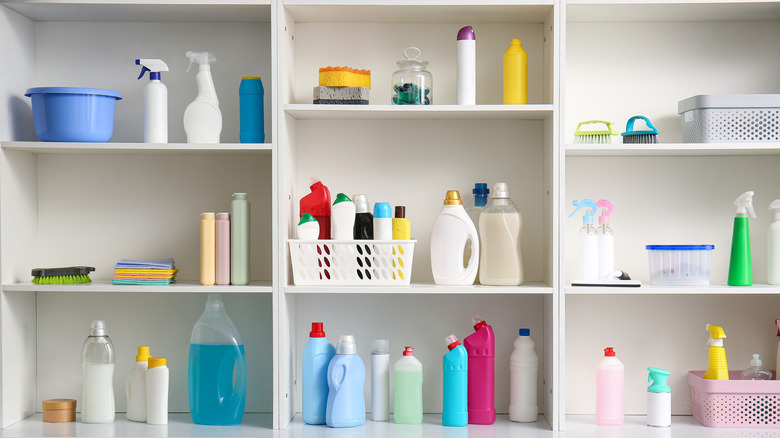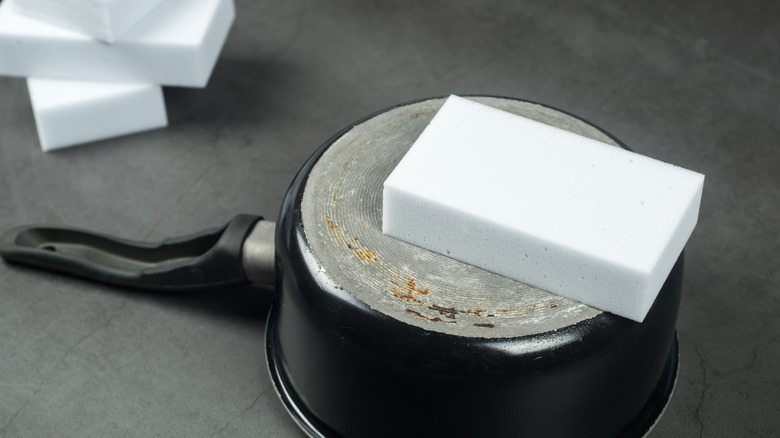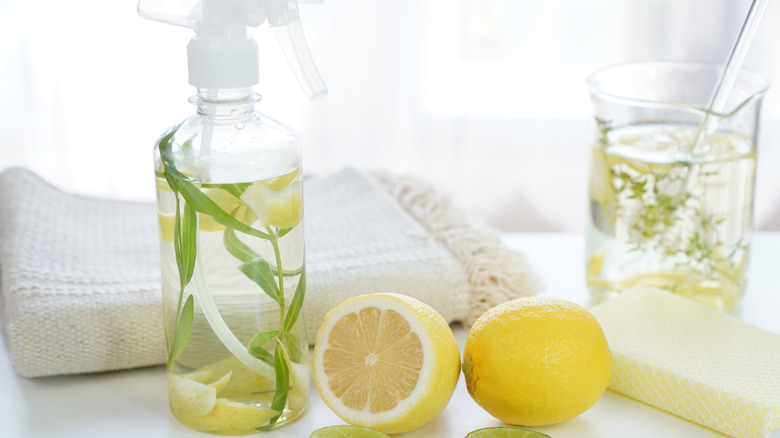The Cleaning Mainstay Scientists (And The Environment) Want You To Stop Using
We may receive a commission on purchases made from links.
Melamine foam sponges — perhaps better known as Magic Erasers — have earned a reputation as household heroes. But science suggests you might want to think twice before using them. These small but mighty sponges can tackle grime that other cleaners struggle with. Walls, bathtubs, sneakers ... you name it. They wipe away dirt from doors, baseboards, handles, and light switches with just a bit of water. Sounds a bit too good to be true, right? Well, maybe it is.
At first glance, they're just simple foam rectangles. How much harm could they really do? But have you ever stopped to ask what that foam actually is? The material that Magic Erasers are made from, melamine foam, are a poly(melamine-formaldehyde) polymer. If that doesn't sound familiar, here's the short version: it's essentially a web of tiny little plastic particles. That's what gives it a scratchy texture and makes it so effective at removing stains.
In short, foam sponges work because they're made of an abrasive plastic material that can scrub away dirt like sandpaper. Convenient? Absolutely. But that's also exactly why scientists are urging caution. Studies from Environmental Science & Technology show that every time you scrub with a melamine foam sponge, you're not just cleaning — you're shedding microplastics. The abrasive action that makes these sponges so effective also breaks them down, releasing tiny plastic particles into the water. From there, they rinse down the drain and straight into the environment and can harm wildlife in the ocean, lakes, and rivers.
Are melamine foam sponges really worse than regular ones?
So, what's the big deal with microplastics? Isn't everything shedding them these days? Sure, even washing synthetic clothes releases microplastics. But ditching your Magic Eraser is such an easy way to cut down your impact. Just ¹⁄₂₅ of an ounce of the sponge can turn into over 6 million microplastic particles. Scale that up, and we're talking trillions of microplastics flooding the environment, all from just this one everyday cleaning tool.
The good news? There are natural, affordable alternatives that work just as well — without as much environmental damage. So really, there's no good reason to keep using melamine foam sponges when better-for-the-planet options are right at your fingertips. What you need is something with enough grit to scrub away dirt, kind of like scratching a lottery ticket. But the golden rule is to stick to natural fibers over synthetic ones. That way, when your sponge eventually breaks down, it's biodegradable and safe for the water and the environment without any microplastics sneaking into the mix.
So, think about what your cleaning sponge is made of before you buy it. Some great eco-friendly options include Airnex coconut fiber sponges, Scrub and Throw biodegradable cleaning pads, and cotton-based rags and sponges. All-natural, effective, and way better for the planet.
Okay, but are these alternatives truly magic?
It's true. Those Magic Erasers aren't like all other sponges. But guess what? The eco-friendly options we just mentioned work just as well if you've got the right method! There are plenty of effective (and less harmful) products hiding in your cabinets that you can use to superpower the scratchy effect of eco-friendly sponges and tackle any kind of mess.
Got crayon on the wall? A little all-purpose cleaner or dish soap will do the trick. Do you think you need a melamine foam sponge to clean your shoes? Swap it out for baking soda or even toothpaste! And for those grimy light switches, mix up a powerhouse solution with vinegar, rubbing alcohol, and hydrogen peroxide. There are plenty of ways to naturally clean your home, like making a homemade vinegar solution to remove many types of dirt and grime.
See? No magic needed — just smart, simple, and eco-friendly cleaning! So why not listen to the scientists and ditch the foam sponges? It won't just be scientists who will thank you, but also birds, fish, and turtles.


